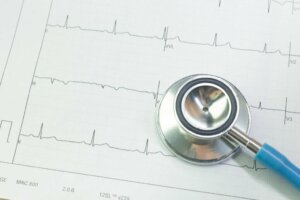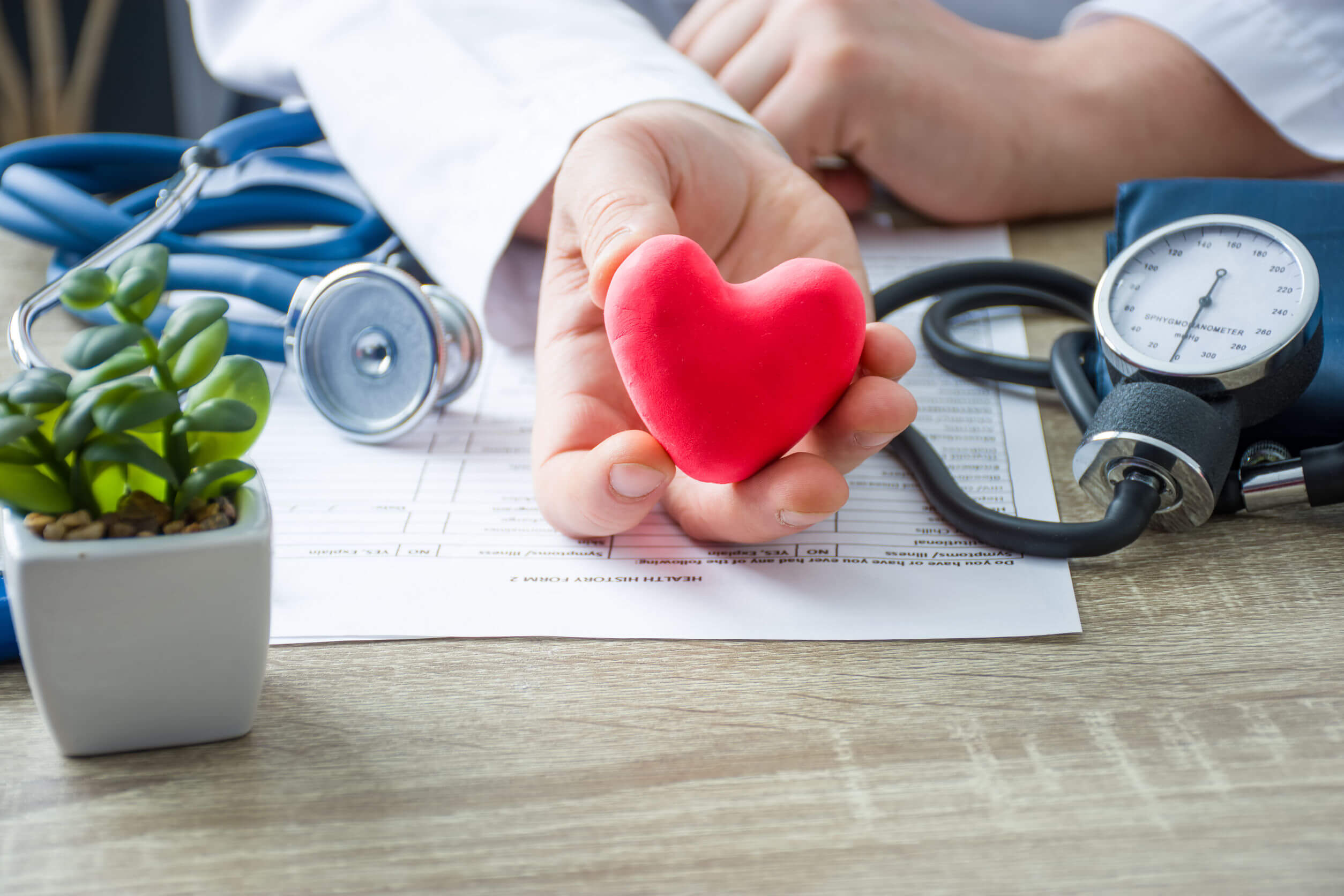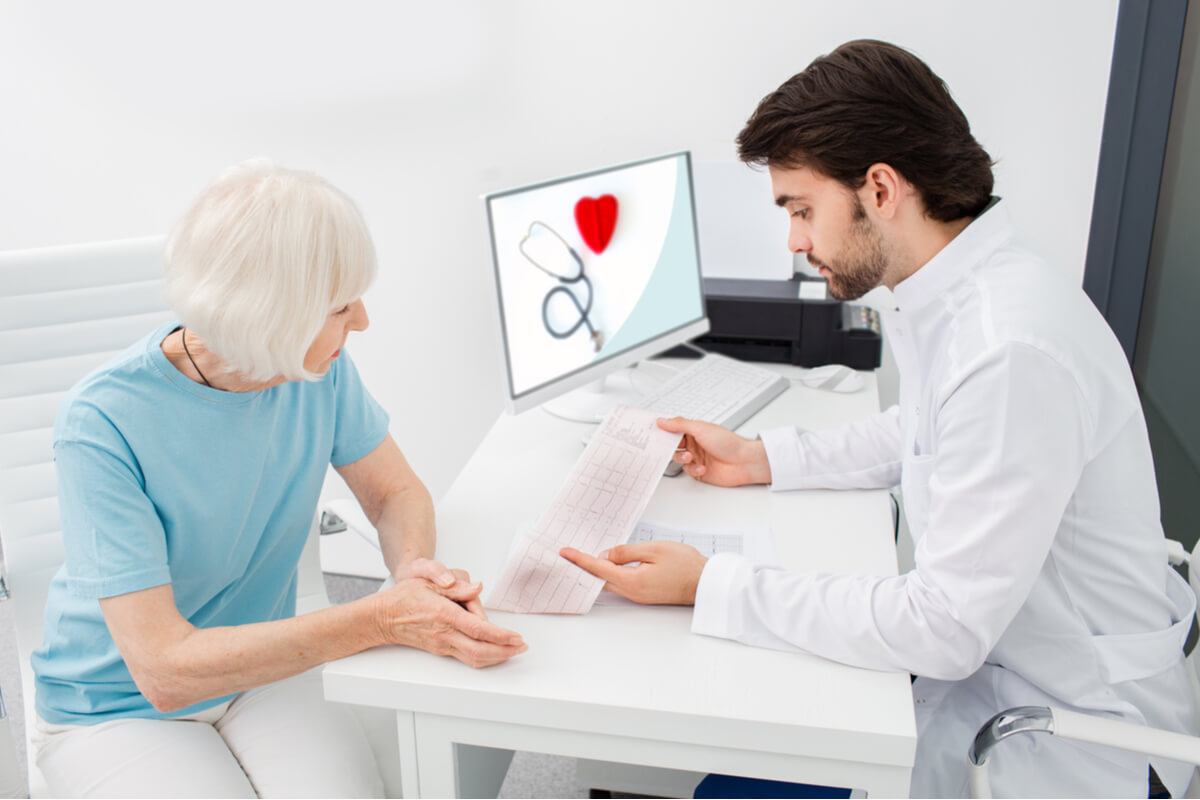What Is Bradycardia?

Experts diagnose bradycardia when the heart rate is slower than normal, when it drops to 60 beats per minute. While it’s true that this isn’t harmful or abnormal (many people such as athletes have these levels) it could become a problem.
In general, this condition occurs when the heart rhythm is so slow and irregular that it affects the pumping of the heart and prevents it from supplying blood to the body. This can be caused by heart block or sinus node dysfunction. Next up, we’ll show you everything you need to know.
Symptoms of bradycardia

Although it’s outside the normal range, some healthy young people and older adults have a heart rate of between 50 and 60 beats per minute. There are even people who experience this decline while they sleep.
As we’ve seen, this only becomes a problem when the heart rate is so slow that the heart doesn’t pump blood well. This affects the functioning of the organs and leads to the appearance of a series of symptoms. In general, these include the following:
- Dizziness
- Fatigue or weakness
- Syncope or fainting
- Dyspnea or shortness of breath
- Chest pain
Likewise, we should take into account that these symptoms can become more frequent with physical exertion, although they can also appear if one is at rest, if you have severe bradycardia.
According to a study published in JAMA Internal Medicine, the risk of dying from bradycardia is low if it’s asymptomatic. However, there’s scientific evidence that shows that symptomatic bradycardias can lead to cardiac arrest when left untreated. However, this is usually very rare.
Causes
Bradycardia has two main causes: heart block and sinus node dysfunction. The latter is the most common. Let’s learn more about it.
Sinus node dysfunction
The sinus node, also known as the sinoatrial node or sinus-atrial node, is a mass of tissue in the right atrium of the heart. It produces and coordinates the electrical signals responsible for beating.
Experts say that if this node generates electrical impulses in a reduced way, the heart rhythm becomes slow and irregular, causing sinus bradycardia. This, in turn, can be temporary or persistent.
Transient sinus bradycardia
This is usually caused by increased vagal tone – this stems from the vagus nerve, a conductive tissue that’s involved in the regulation of the heart, lungs, and digestive tract. Now, when the vagal tone returns to normal, the heart rate does so too, and permanent treatment may not be required.
Permanent sinus bradycardia
This is caused by a disease of the sinus node that can be related to fibrosis, which, in turn, is associated with aging. This is because it’s usually seen more frequently in people 70 years of age or older.
Therefore, this intrinsic disease is the cause of a slow or irregular heartbeat, both at the time of exertion and at rest.
Other causes of sinus bradycardia
There are other conditions that could trigger sinus bradycardia. These are the following:
- Pericarditis
- Myocarditis
- Coronary artery disease
- Heart trauma from injury or surgery
- Hypoxia
- Amyloidosis
- Dysautonomia
- Infections (such as Lyme or Chagas disease)
- Neurological disorders (such as increased intracranial pressure)
- Medications (such as beta-blockers, antiarrhythmics, opioids, among others)
Heart block

Unlike sinus bradycardia, when this condition is caused by heart block, it’s always unusual and appears when the electrical impulses of the heart are blocked in their journey from the atria (where the sinus node is located) to the ventricles of the heart.
This is why the speed of the heartbeat changes. The result of all this is a highly dangerous type of bradycardia that can be transient or persistent.
Transient heart block
This occurs due to conditions such as Lyme disease, thyroid dysfunction, or the toxicity of certain medications. Both treating the underlying disease and using a pacemaker can help in these cases.
Persistent heart block
This occurs as a result of genetic and congenital diseases, as well as others such as sarcoidosis, amyloidosis, and cardiomyopathy. This usually requires permanent treatment, and if you have symptoms only during exertion, then a test will likely be carried out to assess the possibility of inserting a pacemaker.
Diagnosis
To diagnose bradycardia, the specialist indicates and examines an echo-sonogram that allows them to determine if it’s sinus bradycardia or heart block. Later, they’ll establish if it’s transitory, persistent, or caused by an infection, which can be verified in the patient’s medical history.
In some cases, especially in older people, symptoms of sinus node dysfunction and heart block only occur when there’s physical exertion. The doctor can ask for a test, from which they’ll be able to see whether the heart rate suffers an increase or not as a result of that physical activity.
Bradycardia is also detected through outpatient heart rhythm monitoring, which is useful in the case of transient types. Another test that experts will carry out is the electrophysiological study. This test yields definitive results, but it’s also rather invasive.
Bradycardia treatment
Bradycardia treatment will be determined by several factors, whether it is sinus or heart block, as well as whether it is temporary or permanent. Let’s see in detail:
- If bradycardia is due to increased vagal tone, it can be treated if conditions that affect these levels are avoided.
- Persistent bradycardia caused by infection, pericarditis, myocarditis, hypothyroidism, and drug therapy can be reversible by aggressively treating underlying conditions.
- Sinus bradycardia, both reversible and asymptomatic, is treated with periodic evaluation and follow-up.
- When the bradycardia is due to heart block, it isn’t reversible and symptomatic, and must be treated with a permanent pacemaker.
Prevention
Mayo Clinic states that the best way to prevent bradycardia is to reduce the risk of developing heart disease. If you’re already suffering from it, then the recommendation is to control it and follow it up.
Among the recommendations to avoid this type of disease are exercising, following a healthy diet, maintaining a healthy weight, controlling blood pressure and cholesterol levels, not smoking, and drinking in moderation (if you do).
Experts diagnose bradycardia when the heart rate is slower than normal, when it drops to 60 beats per minute. While it’s true that this isn’t harmful or abnormal (many people such as athletes have these levels) it could become a problem.
In general, this condition occurs when the heart rhythm is so slow and irregular that it affects the pumping of the heart and prevents it from supplying blood to the body. This can be caused by heart block or sinus node dysfunction. Next up, we’ll show you everything you need to know.
Symptoms of bradycardia

Although it’s outside the normal range, some healthy young people and older adults have a heart rate of between 50 and 60 beats per minute. There are even people who experience this decline while they sleep.
As we’ve seen, this only becomes a problem when the heart rate is so slow that the heart doesn’t pump blood well. This affects the functioning of the organs and leads to the appearance of a series of symptoms. In general, these include the following:
- Dizziness
- Fatigue or weakness
- Syncope or fainting
- Dyspnea or shortness of breath
- Chest pain
Likewise, we should take into account that these symptoms can become more frequent with physical exertion, although they can also appear if one is at rest, if you have severe bradycardia.
According to a study published in JAMA Internal Medicine, the risk of dying from bradycardia is low if it’s asymptomatic. However, there’s scientific evidence that shows that symptomatic bradycardias can lead to cardiac arrest when left untreated. However, this is usually very rare.
Causes
Bradycardia has two main causes: heart block and sinus node dysfunction. The latter is the most common. Let’s learn more about it.
Sinus node dysfunction
The sinus node, also known as the sinoatrial node or sinus-atrial node, is a mass of tissue in the right atrium of the heart. It produces and coordinates the electrical signals responsible for beating.
Experts say that if this node generates electrical impulses in a reduced way, the heart rhythm becomes slow and irregular, causing sinus bradycardia. This, in turn, can be temporary or persistent.
Transient sinus bradycardia
This is usually caused by increased vagal tone – this stems from the vagus nerve, a conductive tissue that’s involved in the regulation of the heart, lungs, and digestive tract. Now, when the vagal tone returns to normal, the heart rate does so too, and permanent treatment may not be required.
Permanent sinus bradycardia
This is caused by a disease of the sinus node that can be related to fibrosis, which, in turn, is associated with aging. This is because it’s usually seen more frequently in people 70 years of age or older.
Therefore, this intrinsic disease is the cause of a slow or irregular heartbeat, both at the time of exertion and at rest.
Other causes of sinus bradycardia
There are other conditions that could trigger sinus bradycardia. These are the following:
- Pericarditis
- Myocarditis
- Coronary artery disease
- Heart trauma from injury or surgery
- Hypoxia
- Amyloidosis
- Dysautonomia
- Infections (such as Lyme or Chagas disease)
- Neurological disorders (such as increased intracranial pressure)
- Medications (such as beta-blockers, antiarrhythmics, opioids, among others)
Heart block

Unlike sinus bradycardia, when this condition is caused by heart block, it’s always unusual and appears when the electrical impulses of the heart are blocked in their journey from the atria (where the sinus node is located) to the ventricles of the heart.
This is why the speed of the heartbeat changes. The result of all this is a highly dangerous type of bradycardia that can be transient or persistent.
Transient heart block
This occurs due to conditions such as Lyme disease, thyroid dysfunction, or the toxicity of certain medications. Both treating the underlying disease and using a pacemaker can help in these cases.
Persistent heart block
This occurs as a result of genetic and congenital diseases, as well as others such as sarcoidosis, amyloidosis, and cardiomyopathy. This usually requires permanent treatment, and if you have symptoms only during exertion, then a test will likely be carried out to assess the possibility of inserting a pacemaker.
Diagnosis
To diagnose bradycardia, the specialist indicates and examines an echo-sonogram that allows them to determine if it’s sinus bradycardia or heart block. Later, they’ll establish if it’s transitory, persistent, or caused by an infection, which can be verified in the patient’s medical history.
In some cases, especially in older people, symptoms of sinus node dysfunction and heart block only occur when there’s physical exertion. The doctor can ask for a test, from which they’ll be able to see whether the heart rate suffers an increase or not as a result of that physical activity.
Bradycardia is also detected through outpatient heart rhythm monitoring, which is useful in the case of transient types. Another test that experts will carry out is the electrophysiological study. This test yields definitive results, but it’s also rather invasive.
Bradycardia treatment
Bradycardia treatment will be determined by several factors, whether it is sinus or heart block, as well as whether it is temporary or permanent. Let’s see in detail:
- If bradycardia is due to increased vagal tone, it can be treated if conditions that affect these levels are avoided.
- Persistent bradycardia caused by infection, pericarditis, myocarditis, hypothyroidism, and drug therapy can be reversible by aggressively treating underlying conditions.
- Sinus bradycardia, both reversible and asymptomatic, is treated with periodic evaluation and follow-up.
- When the bradycardia is due to heart block, it isn’t reversible and symptomatic, and must be treated with a permanent pacemaker.
Prevention
Mayo Clinic states that the best way to prevent bradycardia is to reduce the risk of developing heart disease. If you’re already suffering from it, then the recommendation is to control it and follow it up.
Among the recommendations to avoid this type of disease are exercising, following a healthy diet, maintaining a healthy weight, controlling blood pressure and cholesterol levels, not smoking, and drinking in moderation (if you do).
- Dharod, A., Soliman, E. Z., Dawood, F., Chen, H., Shea, S., Nazarian, S., Bertoni, A. G., & MESA Investigators (2016). Association of Asymptomatic Bradycardia With Incident Cardiovascular Disease and Mortality: The Multi-Ethnic Study of Atherosclerosis (MESA). JAMA internal medicine, 176(2), 219–227. https://doi.org/10.1001/jamainternmed.2015.7655
- Cedars-Sinai Medical Center. Bradycardia. Available from: https://www.cedars-sinai.org/health-library/diseases-and-conditions/b/bradycardia.html
- Choudhury, M., Boyett, M. R., & Morris, G. M. (2015). Biology of the Sinus Node and its Disease. Arrhythmia & electrophysiology review, 4(1), 28–34. https://doi.org/10.15420/aer.2015.4.1.28
- Jensen, P. N., Gronroos, N. N., Chen, L. Y., Folsom, A. R., deFilippi, C., Heckbert, S. R., & Alonso, A. (2014). Incidence of and risk factors for sick sinus syndrome in the general population. Journal of the American College of Cardiology, 64(6), 531–538. https://doi.org/10.1016/j.jacc.2014.03.056
- Fogoros, R. N. (2012). The Electrophysiology Study in the Evaluation of Bradycardia: The SA Node, AV Node, and His–Purkinje System. Electrophysiologic Testing, 5(5). https://doi.org/10.1002/9781118399613.ch5
- Mayo Clinic [Published 2019 Nov 13]. Bradycardia. Available from: https://www.mayoclinic.org/diseases-conditions/bradycardia/symptoms-causes/syc-20355474
Este texto se ofrece únicamente con propósitos informativos y no reemplaza la consulta con un profesional. Ante dudas, consulta a tu especialista.







